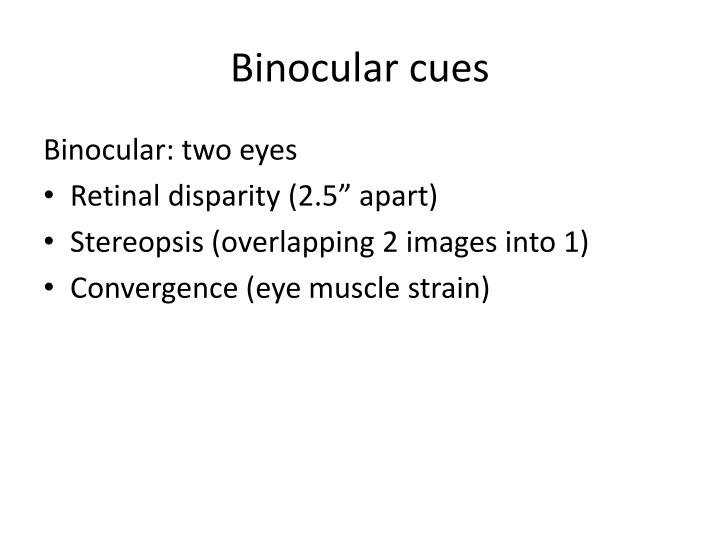

Motion parallax: Motion parallax is when we move our head back and forth. Monocular cues allow us to have some sense of depth perception when true binocular stereopsis is not possible. These are typically categorised into binocular cues that are based on the receipt of sensory information in three dimensions from both eyes and monocular cues that can be shown in just two dimensions and seen with just one eye. What Are Visual Cues That Aid Depth Perception?ĭepth perception is made possible due to an array of depth cues. It can also come in the way of getting certain jobs that need good depth perception.
#Binocular cue full
It can hamper an athlete from reaching his or her full potential. It can cause problems while driving and navigating roads. For instance, it can adversely affect a kid’s ability to learn. So lacking the ability to perceive depth can affect one’s life in more ways than one.

People with only one eye do not have depth perception, as depth perception needs two working eyes. A lack of depth perception can be caused by conditions such as amblyopia, optic nerve hypoplasia, and strabismus. Insects, animals, and fish that have their eyes spaced very far apart and thus have a very high level of depth perception.Ī lack of depth perception can affect some key areas in our lives. The farther the eyes are apart, the better depth perception one has. And while we do use other cues in our environment for depth perception, the most important one is having binocular vision.

If someone lacks this, they will have to depend on other visual cues to gauge depth, and their depth perception will be less than accurate. In other words, having two eyes allows us to have binocular vision. Animals can sense the distance of an object - thanks to their ability to move accurately, or to respond consistently, according to the distance - but it is not known if they “perceive” distance the way humans do.Īmong humans, depth perception takes place due to binocular vision, also known as stereopsis. Depth sensation is the corresponding term for animals. For starters, let’s look at what is depth perception.ĭepth perception is the ability to visually perceive the world and its objects in three dimensions (3D) and the distance of such objects. How does depth perception work? How do humans and cameras detect distances to objects? And why should we know about it? This blog answers some of these questions and more.


 0 kommentar(er)
0 kommentar(er)
